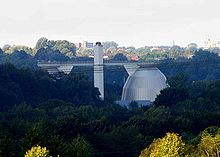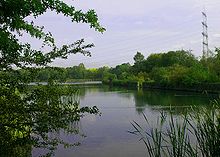Oelbachtal sewage treatment plant
The sewage treatment plant in the Oelbachtal is a sewage treatment plant operated by the Ruhrverband in the Querenburg district of Bochum on the city limits of Witten .
Up to 193,000 m³ of wastewater can be cleaned daily, largely eliminating carbon, phosphorus and nitrogen. The population equivalent is 320,000, the dry cargo 1120 liters per second, the rainy inflow at most twice as much.
The catchment area includes the Gerthe , Langendreer , Harpen , Laer , Altenbochum and Querenburg areas from Bochum and the Bövinghausen and Holte areas from Dortmund . In addition, wastewater from smaller parts of Herne , Castrop-Rauxel and Witten is cleaned. The area from Witten is connected by an approximately 4 km long pressure pipeline from the former Witten sewage treatment plant .
The industrial dischargers include the Ruhr University Bochum (RUB), the Bochum Opel plants and mining ( mine water ). The RUB operates a test facility for wastewater treatment right next to the site.
Leftovers and fats are also delivered to the sewage treatment plant and digested together with the activated sludge in two elevated tanks and then dewatered by centrifuges. The biogas from the digesters is used to operate three combined heat and power units, which produce electricity for their own use, heat for heating the buildings and for hot water preparation, and compressed air for the biological cleaning stage. The dried sewage sludge is removed for disposal.
The city of Bochum, together with the Ruhr Association, offers visits to the sewage treatment plant.
development
Today's sewage treatment plant is already the fourth expansion stage.
In 1922, the first system to be built was a mechanical purification system for the wastewater, which at that time largely came from mining. Just three years later, the sewage treatment plant had to be expanded to three times its capacity due to the increased load.
In 1960 a biological purification stage was added, it had four trickling filters .
From 1972 to 1976 the 50 km² catchment area of the Oelbach was redeveloped in terms of water management. A completely new wastewater treatment plant was built in 1976 to mechanically, biologically and chemically purify the wastewater, which now mostly comes from households. It became the third largest sewage treatment plant along the Ruhr . The sewage treatment plant was also given a sewage sludge drainage system and, from 1978 to 1979, three fining ponds .
From 1995 to 2000, the increased legal requirements made a further expansion and modernization of the sewage treatment plant necessary, which was implemented by 2001.
Fining ponds
The three fining ponds have meanwhile developed into wet biotopes . They are traversed jointly by the cleaned effluent from the sewage treatment plant and the Oelbach. The volume is 360,000 m³ with a surface area of 127,000 m². In dry weather, the wastewater remains in the ponds for three to four days, in rainy weather this can be reduced to less than a day. Some of the ponds are open to the public and are used as a recreational area. Directly behind the last pond, the Oelbach estuary pond, is the Heveney leisure pool . This is followed by the runoff into Lake Kemnader .
See also
Coordinates: 51 ° 27 ′ 3.3 ″ N , 7 ° 17 ′ 18.5 ″ E
Web links
- The Ruhrverband on its sewage treatment plant in the Oelbachtal (PDF; 1.5 MB)
- Aerial photo of the Ruhrverband with the sewage treatment plant
Individual evidence
- ↑ Ruhr University Bochum, Chair for Urban Water Management and Environmental Technology: Test site in Ölbachtal
- ^ Ruhrverband: Bochum-Ölbachtal sewage treatment plant
- ↑ Bochum, Environment and Green Space Office, excursions on the subject of water / wastewater (PDF; 633 kB)
- ↑ http://www.derwesten.de/staedte/bochum/bochum-stadtteile/Reinigte-Wirkung-id1949906.html , accessed on July 18, 2011

